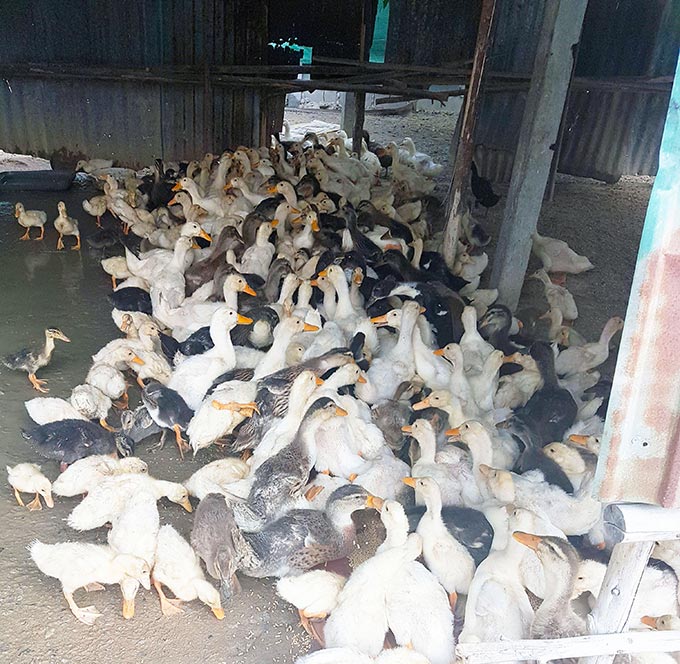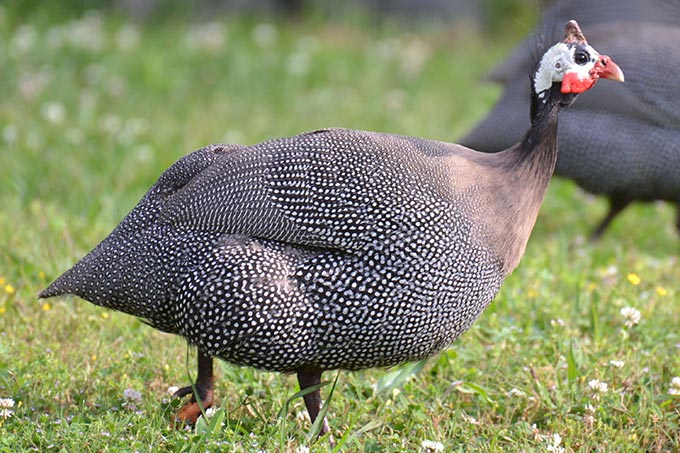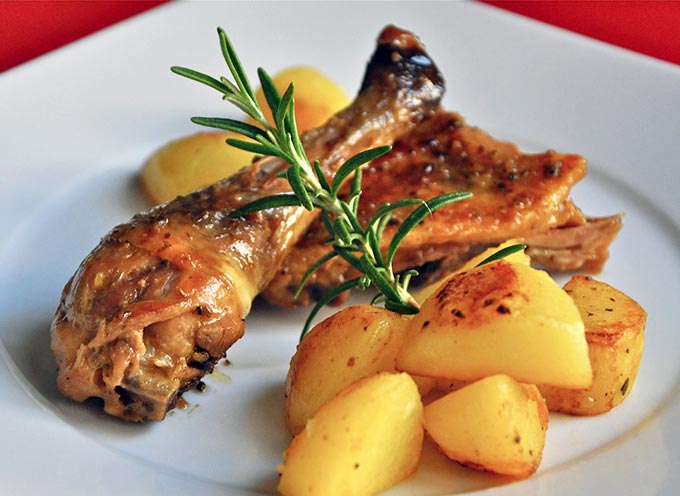At Trattoria Pizzeria Toscana Italian Restaurant and its neighbouring sister Thai restaurant Moom Talay, (both located just south of Soi 6/1 on Pattaya beach road), you can find some fantastic delicacies on the menu including duck and guinea fowl.
Duck

Duck has very high quality meat, very tasty fat, especially appreciated in French and Chinese cuisine. Typical recipes are the duck with orange and lacquered Peking duck.
Also, crispy Peking duck utilizes duck skin along with hoisin sauce and spring onions and cucmber strips wrapped in thin pancakes. In the west the recipie usually utilizes the meat in the same way.
The duck is classified as feathered game, and its meat is classified as “black meat” even though today almost all of the duck meat available on the market belongs to farmed animals.
Duck is a generic term for a water bird belonging to the family Anatidae. The duck is usually a migratory bird that lives in groups and is easily adapted to different environmental conditions and food. The ducks are divided into two major groups: the wild ducks and domestic ducks.
In the past, ducks were raised only at the household level, but today breeding, even intensive, occurs mainly for commercial purposes. It is widespread in Veneto, Emilia-Romagna, Piedmont and Lombardy. The regulations on hunting in Italy, however, are very restrictive, so the duck meat that we find for sale are often sourced from abroad.
Domestic ducks are divided into spring ducks, small and delicate flavor, and autumn ducks, fatter and also flavourful.
The musk duck and Beijing duck are varieties of domestic ducks. As for the wild ducks, the most common species are: Mallard, Garganey, Teal, Pintail, Shoveler and Wigeon.
The duck has very fine meats that can be used in multiple preparations, both fresh and preserved. The duck meat requires a 24-hour period of maturation before being used.
Commonly the meat is cooked on the whole carcass, stuffed with fruit, such as orange or apple, or more elaborate fillings and roasted. The drawback given by the high fat content of its meat can be mitigated by removing the skin where the fat is abundant.
Duck eggs are more delicious than hen’s eggs because they contain more fat and nitrogenous substances.
Guinea fowl

From the organoleptic point of view and taste, the meat of guinea fowl is a sort of compromise between the pheasant and the chicken or turkey. The difference in texture and flavor of wild fowl and the bred fowl is still significant.
The guinea fowl is of medium-large size, about the size of a hen or pheasant or adult rooster. The color of the plumage is dark, swinging from black to gray to bluish, pigmented and white spots.The domestic fowl has a lighter plumage. The head is sometimes covered with feathers and sometimes not.
Guinea fowl is an avian member of the order Galliformes, guineafowl family, gender Numida. There are three species – the meleagris (common fowl), the mitrata (guinea mitrata) and cristata (guinea forelock). Amongst them all, the most brought up is undoubtedly the common fowl, zoologically framed with the binomial nomenclature of Numida meleagris.
Despite the larger size, the guinea fowl has a smaller digestive system justifying in part the greater food need that characterizes it.
Synonyms for “fowl” are: numidica hen, African chicken, chicken, muscovy, hen of Tunis, hen of Mauritania, Libya hen, guinea-fowl, hen of Egypt, and acanques quetele.
Guinea fowl, or rather its wild ancestor, is a native fowl Numidia or Africa agostina, a province of the Roman Empire currently identifiable with North Africa. In these areas, the guinea fowl is still living in the wild. Its massive spread on the European continent took place before the thirteenth century A.D., while, at the hands of sailors and merchant marine, was introduced to the Americas only from the fourteenth century onwards.
The guinea fowl has gregarious habits. They spend the day usually hanging out at water sources while at night they tend to seek shelter (in the bush, on the branches, or in the an elevated henhouse).
In captivity, guinea fowl is not easy to breed. It has a particularly combative character and, unless it has had a prior associated growth since being a chick, does not live together with chickens and hens. There are typically many clashes, leaving fowl regularly damaged.
Managing to win a certain harmony in the hen house, you can still hybridize pharaoh with hens, but not with the pheasants (wild or not).
Despite their typically North African origins, the guinea fowl brilliantly tolerate temperatures much lower than those in equatorial regions, which is why its breeding is quite important also in the Italian peninsula.
Guinea fowl produce both meat and eggs (the latter of which they can lay up to a dozen at a time).While the eggs are consumed exactly like those of hen or turkey or duck, the meat of fowl (especially if captured and not bred) would require a good treatment of maturation and, sometimes, also a short pickling process.
Guinea fowl lends itself to cooking in the oven and grilled.Appropriately and carefully boned, it forms the basis for composing rolls of great value, especially if enriched with eggs, spinach and other boiled vegetables.
In Emilia-Romagna and the Marches, guinea fowl (like the old chicken, osso buco and beef muscle, as well as celery, carrots and onions) is an irreplaceable ingredient for the formulation of meat broth, necessary for the cooking of tortellini, cappelletti, passatelli and more.
The breast of guinea fowl can be a valid substitute for that of other avian species most frequently used, even if the retail price makes it less accessible.
From a nutritional standpoint, the meat of the fowl are almost comparable to those of other avian species. It shows a greater (albeit slight) fatness of the muscle, while the skin is much more full-bodied. This is why the guinea fowl is frequently used for the preparation of meat broth.
The energy content of the guinea fowl, on the whole, is rather moderate and ranks unequivocally among the lean meats. Protein is abundant and of high biological value; They are characterized by the prevalence of the amino acids: glutamic acid, aspartic acid, leucine and lysine, which is limiting tryptophan.
The fat content in the meat of the fowl is low but by contrast, the skin it is very rich in fat as well as cholesterol. The fatty acids of the meat are well distributed and with a slight predominance of monounsaturated fats.
From the point of view of saline it appreciates a fair amount of iron, while for vitamins (as for other meats) it stands out in water-soluble molecules of group B, especially niacin (vitamin PP). The guinea fowl is also a good source of cobalamin (vitamin B12), essential for the prevention of certain fetal complications in pregnant women.











